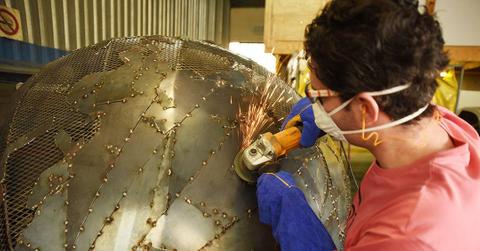Flaming 'Dung Beetle' Turns Plastic Waste Into Green Energy
There's a new way to recycle single-use plastic waste, and it's by using a dung beetle. Art designers have created a sculpture that's able to convert plastic into gas, and the event hopes to inspire others to find inventive concepts to eliminate plastic waste.
Updated May 13 2019, 5:25 p.m. ET
Plastic waste has a significant impact on our environment, but innovators are finding ways to recycle the product into something useful. That was the focus in creating the Dung Beetle, an art sculpture that simultaneously converts single-use plastic into diesel and gas. It’s a unique approach that’s geared toward enhancing the conversation around the environmental issue.
Those unfamiliar with dung beetles should know that, yes, these are insects that roll feces into round balls, and they will feed on them, bury them into the ground, or even live inside them. Similar to how dung beetles are able to eliminate actual waste themselves, converting plastic into gas is also a way to help the environment.
Dung Beetle was created by Alliance Earth along with artist nathan Honey and inventor Pierre “Pops” Pretorius. It made its debut at AfrikaBurn, a Burning Man festival held in South Africa annually. These festivals hold experiments with “radical self-expression,” and that’s certainly evident when this sculpture imitates flaming farts that are over six-feet high.
"Everywhere we went people looked at our system encircled by a steel earth like some sort of alien marvel,” Jeffrey Barbee, a photojournalist and director of Alliance Earth, told Land Art Generator. "In the desert town of Calvinia, children followed the trailer, taking pictures on their cellphones and asking questions."
Instead of creating a generic process of converting plastic waste into gas, this new project was developed to spark attention. The sculpture’s dung ball, created from recycled metal, is where the gasification process takes place, converting plastic into liquefied petroleum gas and diesel gas.
Land Art Generator explains that plastics are first shredded into small particles and then enter a reactor that’s oxygen-free, which limits emissions. Gas that forms rises to the top and runs through cooling ribs, which creates the biofuel. Any plastic particles remaining go through the process again, and the carbon is used for other useful projects “like nano-tubes or graphene sheets.”
“It is a power-producing, fully operational plastic recycling system that turns single use plastics into diesel and gas,” Alliance Earth explains on their website. “The prototype serves to inspire people to copy the free gasification technology.”
Participation is welcomed from the audience for feeding the Dung Beetle with single-use plastic trash. Synthesis gas from the process will generate the flames released from the sculpture and will also power the entire show. Low-emission biodiesel will be used for various vehicles, including the one that moves the sculpture around to its many events.
The project, which weighs in at 2.2 tons, was able to make a 2,000-mile round-trip from Johannesburg, South Africa, to a local desert by using some of the fuel it generated. Barbee says that 2.2 pounds of plastic can be converted into 2 pounds of fuel.
In addition to gaining attention from its farting flames, the creators of the Dung Beetle have an educational show after showing off the sculpture. They detail that fuel generated from this process creates a small amount of greenhouse gas emissions when compared to burning fossil fuels. It also can dramatically decrease plastic’s worldwide carbon footprint.
Flames aren’t even a significant part of the process, used only for art purposes and creating the spectacle itself. However, it’s an ingenious idea to showcase how we can solve a problem like plastic pollution in more ways than just eliminating our use of it.
